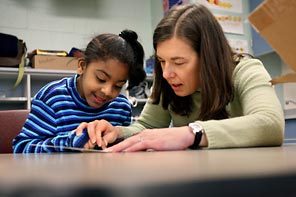Originally published June 2, 2008 at 12:00 AM | Page modified June 2, 2008 at 7:33 AM
One mom's quest to reverse the trend
When Lisa Olszewski started thinking about a school for her daughter, she discovered that few families in her neighborhood thought much...
Seattle Times education reporter
Many of them rejected Muir without having ever stepped foot inside, she said. When she asked them to explain why, "nobody really could."
When she visited, she came away impressed. Students and teachers looked happily absorbed in learning. There was beautiful art on the wall, and students could choose from a variety of after-school activities.
The only thing Muir needed to attract more families from the more-affluent parts of Mount Baker, Olszewski decided, was someone to talk up its virtues. So while her daughter was still in preschool, she appointed herself Muir's chief cheerleader.
Muir is a two-story brick building not far from Franklin High. It is a member of Powerful Schools, an organization that aids seven South End schools with academic support and after-school programs. It has Spectrum classes for high-achieving students. Last year's fourth-grade scores on the Washington Assessment of Student Learning were above the district average in writing, about average in reading and below average in math.
If all the public-school students who live within Muir's main attendance area went to the school, enrollment would be roughly 30 percent white, 30 percent Asian American and 30 percent black. But it's now about 60 percent black, 20 percent Asian American and 13 percent white.
Muir is one of the 30 schools in Seattle with nonwhite populations much higher than the district average. It's also one of the 26 schools that have resegregated since the school district quit the busing that had been designed to increase racial balance at some schools.
For many schools, the racial mix of students reflects the surrounding neighborhood, which leads many to say that Seattle schools are segregated because the city's neighborhoods are segregated.
Muir, however, is one of a number of examples that shows that the issue isn't always a matter of housing patterns. Parental choice can play a role, as well.
A lot of factors go into how parents choose schools: proximity, reputation, programs, test scores, after-school offerings, transportation and more.
Another factor is parents' comfort — or discomfort — with a school's racial mix.
Even if they like a school, for example, parents sometimes shy away if their child would be one of just a few students — or the only student — of a particular race in the school or classroom.
Olszewski worried that kept some Mount Baker families from looking seriously at Muir.
![]()
At the same time, Muir drew families willing to travel to get there.
That was the case for LaKesha Kimbrough, who until recently was PTA president. She lives in Leschi but looked long and hard for a school where she felt the staff truly believed all children could do well.
Kimbrough moved her daughter to Muir from a Catholic school because she felt it would provide the same educational quality. (She's since started home-schooling her daughter, part of her long-term plan.) An added benefit to Muir: Her daughter no longer was one of just two black students in her class.
"She said to me, 'Mama, there's only one white girl in my class.' "
Surella Scott, who also is African American and works at the school, lives in the neighborhood and chose Muir over other schools closer to her home. She liked the racial mix among Muir's teaching staff, the school's small size, the Powerful Schools programs and the fact that its students come from all over the world.
That's also a kind of diversity — and many point out that diversity encompasses more than simply the balance of white and minority students at a school.
"It's not just about race," said Superintendent Maria Goodloe-Johnson. It's language, culture, economics and more.
Challenging stereotypes
Looked at that way, Muir — and many Seattle schools — have a great deal of diversity.
What Muir doesn't have is many white students, and it had even fewer before Olszewski started what amounted to a PR campaign.
To promote Muir, she talked to any parent she could find, collected e-mail addresses and sent messages to a neighborhood listserv every time "anything remotely positive happened." She hosted potlucks for families with children approaching school age, and invited the principals from both Muir and nearby Hawthorne Elementary to meetings of the Mount Baker Community Club, where she was the education chair.
She challenged parents: No matter what they decided, they couldn't reject Muir if they'd never visited the school.
"My feeling was: Group think got us here," she said. And she hoped group think could get more of her neighbors to enroll at Muir.
Olszewski says she wouldn't drive her daughter across town to attend a diverse school, and one reason she lives in the South End of Seattle is so that she doesn't have to.
She's now looking hard for a similar neighborhood — and school — in Melbourne, Australia, where her husband recently got a job.
Nearly two decades ago, John Morefield, then the principal at Hawthorne, walked the streets around that school, determined that when it reopened after remodeling, its student body would reflect its diverse neighborhood.
He heard the same concerns that middle-class parents of all ethnicities often voice about schools such as Muir and Hawthorne, which have a large number of students from lower-income households who, on average, struggle more in school.
Would classes be rigorous enough? Would student behavior be a problem?
His approach was similar to what Awnie Thompson, Muir's principal, does today: Open the school doors wide. The best way to allay fears, Morefield said, was to get parents to come and see for themselves. He knew he had a good school, with a strong staff; that's something he couldn't fake.
Thompson says she encourages parents to visit during recess, or lunch — outside of the official tour times.
Then, she said, they can see for themselves, for example, that student friendships cross racial lines, that teachers have high expectations.
Olszewski also points out that Muir gets extra money for low-income students, she says, and the school has used part of that money to keep class sizes low. That means her daughter's kindergarten class has just 18 students this year. The school also has the resources to provide a better safety net for students who need support, she said.
More whites at Muir
When Olszewski's daughter entered kindergarten last fall, white students made up 13 percent of the school's population — more than in recent memory.
When she runs into people on the street and they ask her where her daughter attends school, she says she now hears: "Oh, I've heard some great things about Muir."
The demographic changes have raised concerns and fears among at least a few of Muir's nonwhite parents that their families may be marginalized.
Scott, for example, welcomes Olszewski's efforts to improve Muir's image but worries that the school's outreach efforts are too focused on Mount Baker, leaving out areas such as Hillman City and Columbia City, where more black and Asian families live.
"All those things that drew me to the school, everybody in the school's boundaries needs to know about them," she said.
Kimbrough says the school needs to address those tensions now, before they grow.
Muir, she said, has the opportunity to be a model for how schools can have constructive conversations about ethnic, religious and economic diversity.
Principal Thompson, who is white, is sensitive to such feelings. She says she works to make sure the message is that Mount Baker parents want to join in, not take over.
"This is a big enough school to accommodate our whole neighborhood," she said. "It's not 'Take back our school.' "
Olszewski says she doesn't want the ethnic mix of the school to change substantially either. She wants a neighborhood school with all the racial diversity in its neighborhood.
"We're lucky in the South End," she said, "that we can have both."
Linda Shaw: 206-464-2359 or lshaw@seattletimes.com
Seattle Times staff reporter Justin Mayo contributed to this report.
Copyright © 2008 The Seattle Times Company
UPDATE - 10:51 PM
Seattle Public Schools name interim financial officer
Jerry Large: It's time to change Seattle schools superintendent's job
OMG! Text lingo appearing in schoolwork
STEM grants help attract more students to sciences
Former Seattle schools attorney reverses course, offers to talk with scandal investigator

general classifieds
Garage & estate salesFurniture & home furnishings
Electronics
just listed
More listings
POST A FREE LISTING




